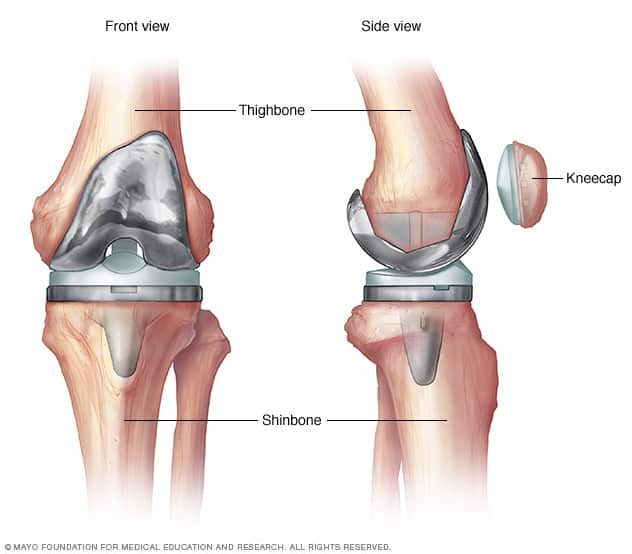Knee Replacement -PSI
Overview:
Knee replacement surgery — also known as knee arthroplasty (ARTH-row-plas-tee) — can help relieve pain and restore function in severely diseased knee joints. The procedure involves cutting away damaged bone and cartilage from your thighbone, shinbone and kneecap and replacing it with an artificial joint (prosthesis) made of metal alloys, high-grade plastics and polymers. In determining whether a knee replacement is right for you, an orthopedic surgeon assesses your knee's range of motion, stability and strength. X-rays help determine the extent of damage.Your doctor can choose from a variety of knee replacement prostheses and surgical techniques, considering your age, weight, activity level, knee size and shape, and overall health.
When Surgery Is Recommended?
There are several reasons why your doctor may recommend knee replacement surgery. People who benefit from total knee replacement often have:
- Severe knee pain or stiffness that limits everyday activities, including walking, climbing stairs, and getting in and out of chairs. It may be hard to walk more than a few blocks without significant pain and it may be necessary to use a cane or walker
- Moderate or severe knee pain while resting, either day or night
- Chronic knee inflammation and swelling that does not improve with rest or medications
- Knee deformity — a bowing in or out of the knee
- Failure to substantially improve with other treatments such as anti-inflammatory medications, cortisone injections, lubricating injections, physical therapy, or other surgeries
What happens during the procedure?
Most knee replacement surgery is performed under a combination of general anesthesia, peripheral nerve blocks, and spinal (epidural) anesthesia. You will also receive at least one dose of antibiotics to reduce the risk of infection.
- During the procedure, the surgeon will remove bone and diseased cartilage from where your thigh bone (femur) and shin bone (tibia) meet at your knee joint.
- Those surfaces are then replaced with a metal implant. A piece of special plastic is normally used to replace the backside of the kneecap and finally, this same plastic material is placed in between the two metal parts.
- This gives both bones of your knee joint smooth surfaces again so they can flex and bend more freely and painlessly.
- After surgery
- Most patients spend 2–3 nights in the hospital following a total knee replacement.
- The doctor will prescribe pain medication and will monitor you for complications.
- Shortly after your operation, a physical therapist will start helping with the following: weight-bearing therapy, including standing and walking a combination of physical and occupational therapy to help you adapt to your new knee
- You will need to continue these exercises at home.
- When you are able to perform certain tasks, such as getting out of bed alone and using the bathroom, you will be able to go home.
- You may need to use a cane or walker for a short period of time after your operation.
Total knee replacement recovery
Most of your recovery and rehabilitation will be at home after you leave the hospital. Some people need home health care or assistance. Your doctor will most likely prescribe physical therapy at a local clinic for continued rehabilitation. The physical therapist at this clinic will suggest exercises you can do at home.
Everyone recovers differently, but most people are allowed to return to driving by the end of 4 weeks.
It may be a good idea to prepare your home for your return before having surgery.
Preparing for surgery
Some weeks before the procedure, your surgeon will take you through a preoperative evaluation, or pre-op. They will ask you questions about:
- your overall health
- your medical history
- any medications and supplements you use
- any specific concerns you may have
They will also do the following:
- Carry out tests to check that you are ready for the procedure and assess for possible complications. These may include kidney and lung tests.
- Ask you to sign a consent form and provide details of emergency contacts.
- Let you know of any preparations you should make before the day. For example, you may need to stop taking certain medications temporarily.
Total knee replacement cost
- Cost can vary, depending on where you have the procedure and your overall health at that time.
- If you have other conditions that are not related to your knees, they may affect the procedure and cost as well.
- When considering the cost of the procedure, you should also consider additional costs for:
- your hospital stay
- physical therapy in the hospital
- therapy during your recovery at home
- follow-up appointments and care
- getting help at home
- transportation costs
You’ll also need to know how much your insurance will cover and how much you’ll need to pay from your own pocket.
Risks of the procedure:
As with any surgical procedure, complications can occur. Some possible complications may include, but are not limited to, the following:
- -Bleeding
- -Infection
- -Blood clots in the legs or lungs
- -Loosening or wearing out of the prosthesis
- -Fracture
- -Continued pain or stiffness
The replacement knee joint may become loose, be dislodged, or may not work the way it was intended. The joint may have to be replaced again in the future.
Nerves or blood vessels in the area of surgery may be injured, resulting in weakness or numbness. The joint pain may not be relieved by surgery.
There may be other risks depending on your specific medical condition. Be sure to discuss any concerns with your doctor prior to the procedure.
Results

- For most people, knee replacement provides pain relief, improved mobility and a better quality of life. And most knee replacements can be expected to last more than 15 years.
- Three to six weeks after surgery, you generally can resume most daily activities, such as shopping and light housekeeping. Driving is also possible at around three weeks if you can bend your knee far enough to sit in a car, if you have enough muscle control to operate the brakes and accelerator, and if you're not still taking narcotic pain medications.
After recovery, you can engage in various low-impact activities, such as walking, swimming, golfing or biking. But you should avoid higher impact activities — such as jogging, skiing, tennis and sports that involve contact or jumping. Talk to your doctor about your limitations.
Sources:
- Total Knee Replacement Surgery - Patient Specific Implants (PSI)- You Tube Video
- https://www.youtube.com/watch?v=yLbiEqScyPs
- Mayo Clinic:
- https://www.mayoclinic.org/tests-procedures/knee-replacement/about/pac-20385276
- Ortho Info:
- https://orthoinfo.aaos.org/ en/treatment/ total-knee-replacement/
- Medicine Net:
- https://www.medicinenet.com/ total_knee_replacement/ article.htms
- Health Line:
- https://www.healthline.com/ health/total-knee-replacement-surgery#5- Reasons-to-Consider-Knee-Replacement-Surgery


